Sabudana pakoda recipe with step-by-step photos – sabudana pakora is yet another snack that can be made during fasting or Vrat days. These sabudana pakoda can be made for fasting on Ekadashi or Navratri or even for Janmashtami or on any other Hindu religious fasting day.
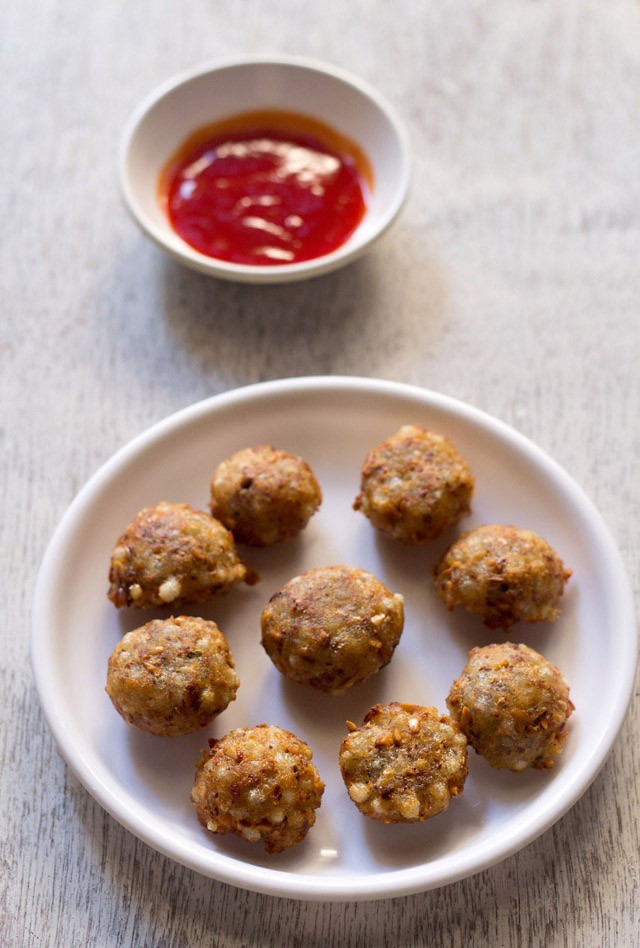
These pakoras are simple and easy to make and they also make for a nice breakfast or evening snack. I make these sometimes for an evening snack and we enjoy them with tomato sauce or coriander chutney. Few more fasting snacks recipes on the blog are:
These sabudana pakoras are slightly different from the Maharashtrian Sabudana Vada. Here I add some buckwheat flour (kuttu ka atta) to the pakora mixture and excluded some ingredients like lemon juice and coriander leaves. So the taste and flavor is different.
Apart from buckwheat flour, the other main ingredients in this recipe are sabudana or tapioca pearls, roasted peanuts, and potatoes. The peanuts give crunchy taste and add flavor. Mashed potatoes and buckwheat flour help in binding the pakora. Apart from that buckwheat flour also absorbs extra moisture, if any.
Since I get pretty hard sabudana pearls here, I always soak them overnight. By morning they soften really well. So depending on the quality of the pearls, you can soak them overnight or for a few hours.
How to make Sabudana Pakoda
1. Soak the sabudana or tapioca pearls in enough water overnight or for 4 to 5 hours. Later drain all of the water very well using a strainer and keep aside the sabudana in a mixing bowl.
Depending upon the quality of sabudana you can choose to soak for 2 hours or more as needed. I always soak sabudana overnight.
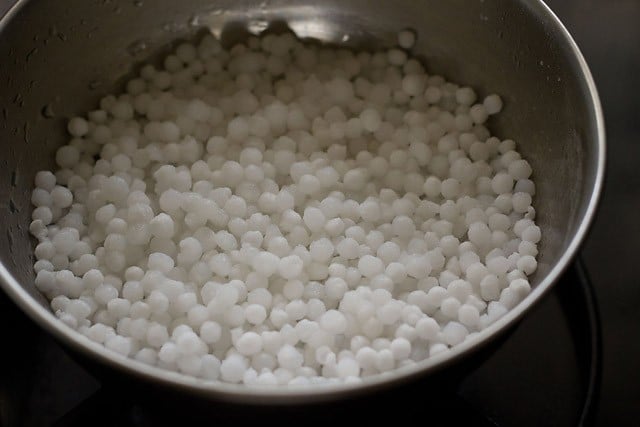
2. Boil the potatoes in a pan or pressure cooker. When they cool, peel and chop roughly.
Roast the peanuts in a pan till browned and crisp. In a mortar-pestle, coarsely crush the roasted peanuts.
Add the following ingredients to the soaked sabudana
- chopped boiled potatoes
- crushed roasted peanuts
- cumin seeds
- chopped green chilies
- sugar
- buckwheat flour
- edible rock salt as required
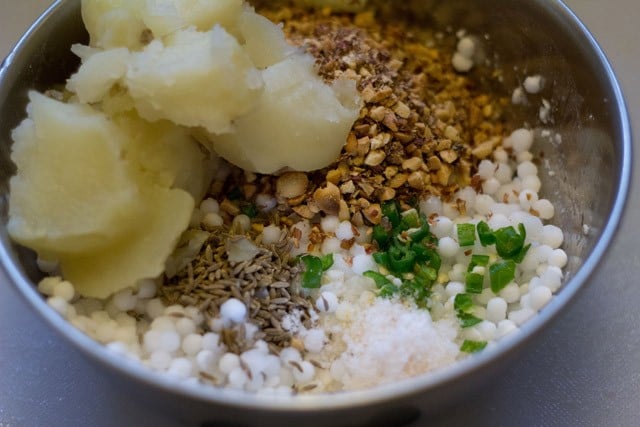
3. Mix the ingredients really well using a spoon or with clean hands. Check the taste and add more salt or sugar if required.
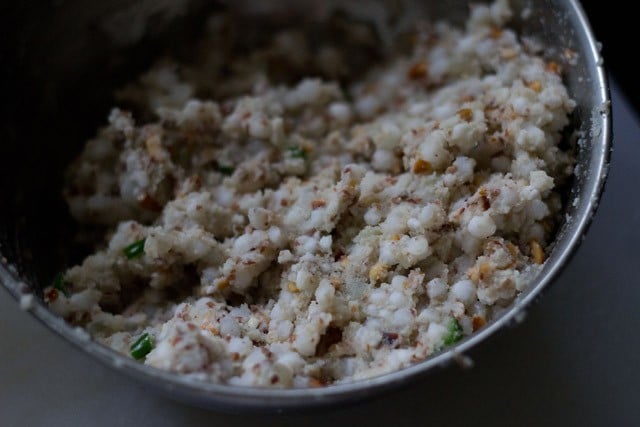
4. Heat oil for frying in a kadai or pan. Make small balls of the mixture with your hands or using a spoon drop the mixture in medium hot oil carefully. Keep the heat to medium to medium-high.
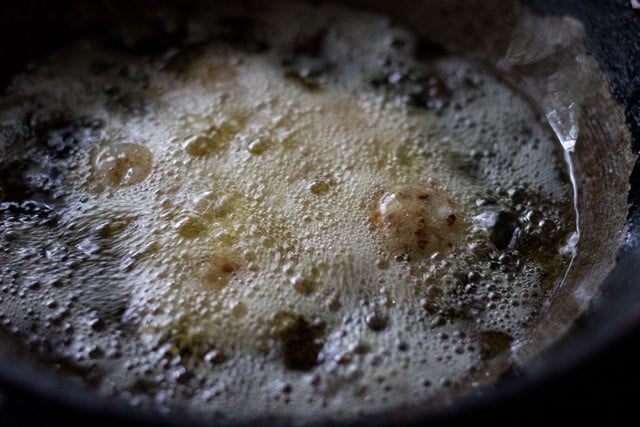
5. First let the sabudana pakoda become opaque and lightly golden while frying and then turn them with a slotted spoon. Don’t be in a hurry to turn them as this will break them in the oil. So first let the pakoda firm up and become light golden before turning over.
Deep fry the second side till they are golden and crisp. You can turn them a few times with a slotted spoon as needed to get an even golden color.
Once perfectly fried, then remove them on paper napkins to remove excess oil.
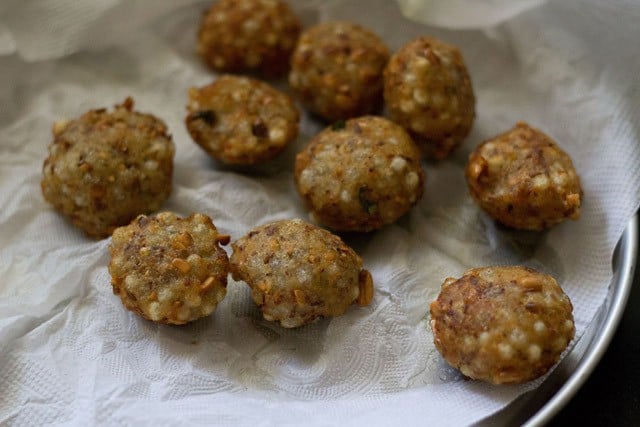
If you are making these Sabudana pakodas for fasting/vrat then serve them with Phalahari chutney or saunth chutney or homemade tomato sauce. Otherwise you can serve sabudana pakoras with any green chutney or mint chutney.
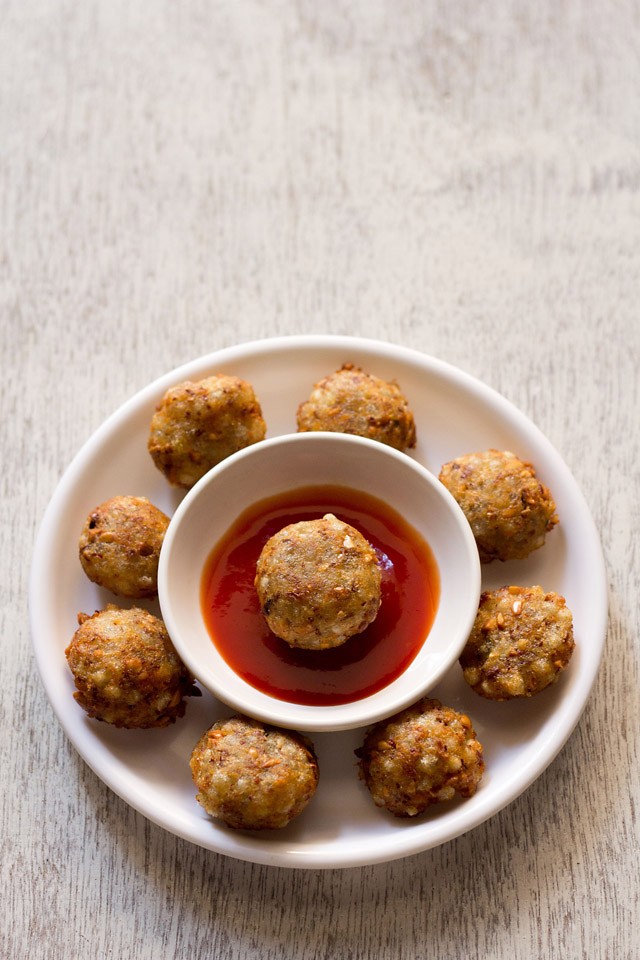
Tips for Sabudana Pakora
- If making these as an evening snack, use regular salt. When making for any Hindu fasting days, add edible rock salt.
- Make sure the oil is medium-hot while frying. A lesser hot oil will make these pakoda absorb too much of oil and a very hot oil will brown them quickly or burn them.
- Instead of buckwheat flour, you can use amaranth flour, water chestnut flour. If making for non-fasting days, use rice flour, gram flour (besan) or cornstarch.
- When making any fasting snack I use peanut oil for frying. However if you are making these pakora for regular non-fasting days then you can use any neutral-flavored oil.
- You can even shallow fry them but flattened the balls slightly when you shallow fry them.
I have few more Sabudana Recipes on my blog that you might like to check like:
Please be sure to rate the recipe in the recipe card or leave a comment below if you have made it. For more vegetarian inspirations, Sign Up for my emails or follow me on Instagram, Youtube, Facebook, Pinterest or Twitter.
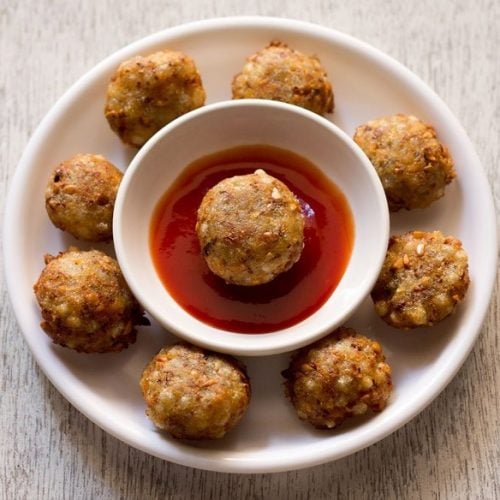
Sabudana Pakoda | Sabudana Pakora
Ingredients
- ½ cup sabudana (tapioca pearls)
- 1 large potato
- ¾ teaspoon cumin seeds
- ½ to 1 teaspoon sugar
- 1 green chili , chopped
- 2 tablespoon kuttu ka atta (buckwheat flour)
- ¼ cup peanuts
- rock salt (edible and food grade) or sendha namak, add as required
- oil as needed for frying
Instructions
Making sabudana pakoda mixture
- Soak the sabudana or tapioca pearls in enough water overnight or for 4 to 5 hours.
- Later drain all of the water very well using a strainer and keep aside the sabudana in a mixing bowl.
- Boil the potatoes, peel and chop roughly.
- Roast the peanuts in a pan till browned and crisp.
- In a mortar-pestle, coarsely crush the roasted peanuts.
- Add all ingredients to the drained sabudana, including the chopped potatoes and peanuts.
- Mix the ingredients really well using a spoon or with clean hands. Check the taste and add more salt or sugar if required.
Frying sabudana pakoda
- Heat oil in a kadai or pan.
- Make small balls with your hands or using a spoon drop the mixture in to medium hot oil. Keep the heat to medium to medium-high.
- Let the pakoras become opaque and then turn them with a slotted spoon.
- First let the sabudana pakoda become opaque and lightly golden while frying and then turn them with a slotted spoon. Don’t be in a hurry to turn them as this will break them in the oil. So first let the pakoda firm up and become light golden before turning over.
- Deep fry the second side till they are golden and crisp. You can turn them a few times with a slotted spoon as needed to get an even golden color.
- Once perfectly fried, then remove them carefully with a slotted spoon draining as much oil as possible.
- Place them on paper napkins to remove excess oil.
- Serve sabudana pakodas hot or warm with tomato sauce or green chutney or coconut chutney. If you are making them for fasting then serve them with phalahari chutney.
- Best to have them hot for best taste.
Notes
- If making for kids or folks who cannot tolerate chilies, then skip the green chili completely.
- When making for any Hindu fasting days ekadashi or navratri fast, do add edible rock salt only. However if making them for regular non-fasting days then you can add regular salt instead of rock salt.
- Instead of buckwheat flour, you can use other fasting flours like amaranth flour, water chestnut flour. If making for non-fasting days, use rice flour, gram flour (besan) or cornstarch.
- Make sure the oil is medium-hot while frying.
- When making for fasting days I fry them in peanut oil.
Nutrition Info (Approximate Values)
This Sabudana Pakora post from the archives first published in August 2013 has been updated and republished on June 2022.

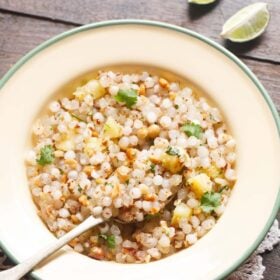

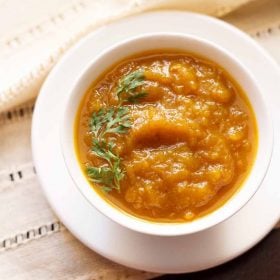








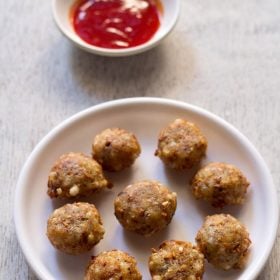
Hello, thanks for sharing this interesting recipe. I’d like to try it out but need to know ,if you don’t have buckwheat flour will substituting with besan(chickpea flour) work as well? Would you have to boil the potato first or can you use raw grated potato directly? Thanks for any advice
zeen, you can use besan. you can use rice flour also. potatoes are boiled and then added. raw grated potato can give a different texture.
I like all ur recipes. Whenever I try some new recipes, i use to follow ur recipes. It’s really a Best recipe guide.
Hi,
Thanks for sharing d great receipe, one thing
I want to knw which oil shld we use while fasting
Thanks
peanut oil. thats what i use. for frying i use peanut oil. you can also use ghee for making sabzi, kadhi and curries.
Sabudana pakore .. Really fantastic!
Please share some evening easy to cook snacks recipes…thank you and i love this site
welcome piyali. i will add.
What is kuttu ka atta?
asma, kuttu ka atta is buckwheat flour and is commonly used during fasting or vrat days.
Hey Dassana,
I tried out this . I dont have buckwheat flour and hence used atta.. This came out really well.. My hubby and my 2-yr old daughter loved it…. Thanks guys…keep the good work going..
welcome swetha. thanks for sharing your positive feedback.